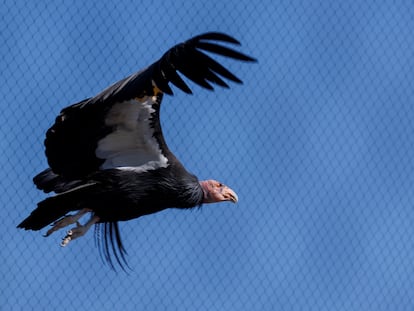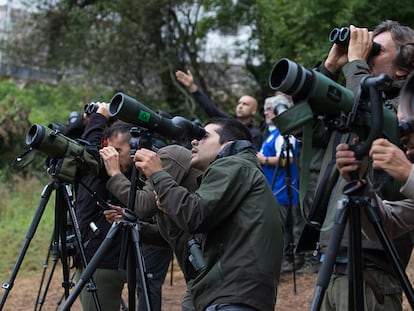From snowy owls to bobolinks: Tracking the rarest birds ever seen in Spain
Every year, around 80 species whose natural habitat is far from the Iberian peninsula are sighted by enthusiastic birdwatchers who don’t mind long trips and longer waits to get a glimpse of these uncommon visitors
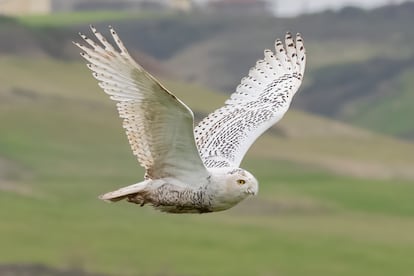
Every year, around 80 bird species whose natural habitat is far away from Spain are sighted in the country. These natives of the Americas, Asia, Africa and northern Europe usually end up here after taking a wrong turn in their migration routes or after being caught in storms with strong winds that push them towards unknown destinations.
Many of them die along the way, but a few do manage to reach land, sometimes aboard ships where they perch to rest from their efforts or to take refuge from a storm. This is what experts suspect happened in the case of two North American snowy owls that recently showed up in the northern Spanish region of Asturias.
The pair has not been seen again for days, but birdwatchers continue to stand guard at the foot of the cliffs in Cabo Peñas, excited at the prospect of bearing witness to what is widely viewed as the rarest bird sighting ever recorded in Spain.
Uca Díaz, a resident of the northern city of Santander, is part of the legion of birdwatchers who have descended on Cabo Peñas for a glimpse of these rare visitors. She has already seen them once, but she keeps coming back every day after dropping off her daughter at school.
“To see a snowy owl, which should be going down from Canada to Boston or New York but is instead in Asturias, the two-hour drive is worth it,” says Díaz, 46, who became interested in birds 20 years ago. Her interest soon turned into passion. “I’ll never forget the time when my daughter and I were sitting in the car, it was raining outside, she was sitting on the potty and I was making a video recording of a greater hoopoe-lark, a rare bird from Africa,” she recalls.
These specimens can only be spotted “by putting in a lot of hours,” confirms Gonzalo Pardo de Santayana, secretary of the rare birds committee of SEO/BirdLife, a Spanish ornithology association founded in 1954. Cabo Peñas is a key location because a lot of species coming in from the sea pass through this spot.
“You would have to know that October is the month of the year when rare birds are most likely to come in through that area, and you would have to go there every day,” he explains. “There’s the enduring allure of finding a mega-rare species, and that’s what makes you go back again and again.”
Some of the most spectacular birds seen in Spain in recent memory include an Atlantic yellow-nosed albatross that showed up last year at Cape Estaca de Bares, in the Galician province of A Coruña, which is Spain’s northernmost point and the best spot to watch migrating birds. “It might have veered off course by as much as 5,000 kilometers, but we don’t really know because this is one of the birds with the longest wingspan [2.3 meters] and they fly long distances,” adds the expert, explaining that they breed in the southern hemisphere and can travel hundreds of kilometers to find food for their chicks.
Pardo believes it is possible that this particular bird returned to its natural habitat around a week later. “It may have associated itself with a group of gannets or some other species that travels between the hemispheres and changed its migration route,” he posits.
Getting back home to the Americas will be harder for the bobolink, a little bird the size of a sparrow that was found on a golf course in Jandía, on the island of Fuerteventura, on September 19. “These tiny species face a certain death,” explains Pardo. September is hurricane season in Central America and the west-east winds very likely pushed the little creature further and further into the Atlantic. Going home would mean another ocean crossing, this time against the wind. Mission impossible.
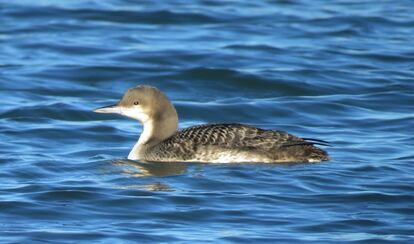
But these are not the rarest birds ever spotted in Spain. The truly “extreme rarities” were a Siberian blue robin that was caught and ringed in Catalonia’s Ebro delta in October 2000, and a Naumann’s thrush found two years later in the same area, notes Ricard Gutiérrez, a zoologist who keeps the blog Rare Birds in Spain. “Why do we like rare birds? It’s an identification challenge that also raises questions and provides clues as to whether we are seeing a rise in certain climate events such as cold waves or hurricanes,” he says.
So what was a Pacific loon doing in a dam in Caspe, Zaragoza province, in the winter of 2020? It should have been in China, Japan, United States or Mexico – somewhere on the coast of the Pacific Ocean. Instead, it crossed the Atlantic and much of the Iberian peninsula to end up in Civán reservoir, in inland Spain. News of the sighting led to a scramble by rare bird hunters eager to catch a glimpse of the wandering loon. “Since they migrate to Mexico and that land area is not very wide, it might have crossed over from the Pacific to the Atlantic, but to actually cross the entire Atlantic is to feel pretty confident about yourself,” notes Pardo.
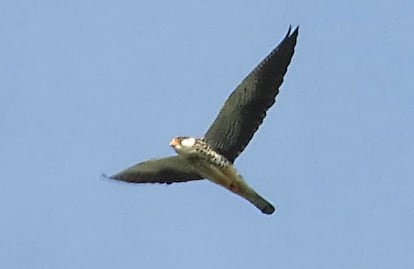
And then there was the Amur falcon, an Asian species that has only been seen twice in Spain: once in the Canary Islands, which are located off the coast of northwestern Africa, and again this past August in the Valencia region. A very gregarious bird, it roosts in huge colonies, breeds in Mongolia, northern China and southern Russia, and flies from these areas to India where it crosses the Indian Ocean on its way to South Africa to spend the winter, representing a journey of around 8,000 kilometers. Experts are unsure how one of these birds ended up in the Iberian peninsula instead, but they suggest it probably got separated from the group and wandered until it found land. Because these falcons are good fliers, this specimen is expected to be able to return home.
These rare birds are so attractive – particularly the really impressive ones such as the snowy owl, made famous by the Harry Potter movies – that dozens of people may show up and end up disturbing them. To avoid this, SEO/BirdLife has developed an ethical code because “the main thing is the bird’s welfare, and we need to avoid getting close just to get a good photograph,” says Pardo, speaking himself from Cabo Peñas, where he was hoping for a glimpse of the elusive owls.
Tu suscripción se está usando en otro dispositivo
¿Quieres añadir otro usuario a tu suscripción?
Si continúas leyendo en este dispositivo, no se podrá leer en el otro.
FlechaTu suscripción se está usando en otro dispositivo y solo puedes acceder a EL PAÍS desde un dispositivo a la vez.
Si quieres compartir tu cuenta, cambia tu suscripción a la modalidad Premium, así podrás añadir otro usuario. Cada uno accederá con su propia cuenta de email, lo que os permitirá personalizar vuestra experiencia en EL PAÍS.
¿Tienes una suscripción de empresa? Accede aquí para contratar más cuentas.
En el caso de no saber quién está usando tu cuenta, te recomendamos cambiar tu contraseña aquí.
Si decides continuar compartiendo tu cuenta, este mensaje se mostrará en tu dispositivo y en el de la otra persona que está usando tu cuenta de forma indefinida, afectando a tu experiencia de lectura. Puedes consultar aquí los términos y condiciones de la suscripción digital.
More information
Últimas noticias
Most viewed
- Reinhard Genzel, Nobel laureate in physics: ‘One-minute videos will never give you the truth’
- Oona Chaplin: ‘I told James Cameron that I was living in a treehouse and starting a permaculture project with a friend’
- Pablo Escobar’s hippos: A serious environmental problem, 40 years on
- Charles Dubouloz, mountaineering star, retires at 36 with a farewell tour inspired by Walter Bonatti
- Why we lost the habit of sleeping in two segments and how that changed our sense of time

